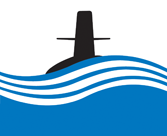
The RAN Oberon Class
The RAN Oberon Class
Oberon Class -Â The First Australian Submarine Squadron
The “Oberon” class was one of the most advanced type of conventional submarines in any navy, combining high speed with great underwater endurance. They were attack submarines, with both anti-surface and anti-submarine capabilities. Designed specifically for silent running, they were amongst the quietest operational submarines in the world, including nuclear submarines. They were therefore extremely difficult to detect and were ideally suited to operations on an enemy’s “doorstep”. Equipment included sensitive long-range underwater listening devices and electronic fire-control systems. They were fitted with a “snort” system, which enable batteries to be recharged while the submarine remained submerged. Moulded fibreglass had been used extensively in the construction of the casing and fin (sometimes referred to as the 'sail').
The Royal Navy's 4th Submarine Squadron, which included “T” class submarines, was disbanded on 10 January 1969 when the 1st Australian Submarine Squadron comprising OTWAY and OXLEY was founded.
The rebirth of the Australian Submarine Service followed the decision of the Naval Board, in 1963, to order four of the highly successful British “Oberon” class vessels for the RAN. The orders were placed with Scotts yard at Greenock and each vessel took just under three years to build. In the tradition of their predecessors of some forty years before, they were named in honour of men who figured in early Australian exploration.
Soon after the keel of the first of the four was laid down, the RAN began sending volunteers for submarine training with the Royal Navy. This flow of personnel was maintained as the building programme progressed, and so as each vessel was commissioned she was manned almost entirely by RAN officers and sailors.
HMAS OXLEY, the first submarine built for the RAN for almost forty years, was launched on 24 September 1965 by Lady Downer, wife of Sir Alex Downer, Australian High Commissioner in the United Kingdom. She was commissioned on 27 March 1967 by Lieutenant Commander D.H. Lorrimer RAN. After leaving the United Kingdom on 12 June, she reached Sydney on 18 August 1967, where she was moored at HMAS PLATYPUS, the new RAN submarine base which was commissioned on the day of OXLEYs arrival. She was the first RAN submarine to pass through the Panama Canal. OXLEYs original pennant number was S57 and in 1969 it was reduced to 57.
HMAS OTWAY was the second “Oberon” class submarine to be completed for the RAN. She was launched by Princess Marina, Duchess of Kent on 29 November 1966 and commissioned at Greenock on 23 April 1968 by Lieutenant Commander G.R. Dalrymple RAN. On 23 July OTWAY departed Portsmouth for Australia and arrived at Sydney on 7 October 1968. Her pennant number was 59.
On 10 January 1969 OTWAY escorted HMS TRUMP, last of the Royal Navy’s 4th Submarine Squadron based in Australia, out of Sydney Harbour as TRUMP departed for the United Kingdom.
The third submarine completed for the RAN was HMAS OVENS. She was launched on 4 December 1967 by Lady Slim, wife of Viscount Slim, a former Governor-General of Australia. She was commissioned on 15 April 1969 under the command of Lieutenant Commander B. Nobes RAN. OVENS departed the United Kingdom on 1 August and arrived at Sydney on 17 October 1969. OVENS was the first RAN submarine to serve with ANZUK forces under the Five Power Defence Agreement in the Far East in 1972. Her pennant number was 70.
HMAS ONSLOW was the fourth “Oberon” class submarine completed. She was launched by Princess Alexandra on 3 December 1968 and commissioned on 22 December 1969 by Lieutenant Commander C. Nixon-Eckersall RN. She departed for Australia in April 1970 and arrived at her Sydney base, HMAS PLATYPUS, on 4 July that year. Her pennant number was 60.
Two further “Oberon” class submarines were completed for the RAN some eight years later. They were similar in most respects to the earlier four Oberons but incorporated important design improvements including the provision of a long range passive ranging sonar, which was retro-fitted to the four earlier submarines.
HMAS ORION was the fifth submarine to be completed. She was launched on 16 September 1974 and commissioned on 15 June 1977 under the command of Lieutenant Commander R.J.H. Woolrych RAN. Her pennant number was 61. The name ORION is linked to the constellation of Orion, which is visible in the Southern Hemisphere.
The sixth and final “Oberon” class submarine completed for the RAN was HMAS OTAMA. She was launched on 3 December 1975  by HRH Princess Anne and commissioned on 27 April 1978 under the command of Lieutenant Commander F.V.R. Wolfe RAN. OTAMA’s pennant number was 62. The name OTAMA is a northern Aboriginal word meaning 'dolphin'.
The Update Programme
By the early 1970s, it became apparent that the original Royal Navy sensors, weapons and fire control system of the Oberon submarines were becoming obsolete and would not meet the RAN’s requirement until the end of the submarines' life. A number of projects were initiated to update this capability – the overall programme being known as the Submarine Weapons Update Programme (SWUP). Due to the lack of RN and USN development in conventional submarines, the selection, integration and design was carried out by the RAN.
The heart of the SWUP was the digital Submarine Fire Control System (SFCS) which was built by Singer Librascope to RAN philosophy. Other equipment included in the SWUP were CSU3-41 Attack Sonar, AN/BQG Passive Ranging Sonar, WSN-2 Gyro Compass, MK48 Torpedo and later modifications for the UGM-84 Encapsulated Harpoon Missile. HMAS OXLEY completed her SWUP update on 18 December 1979, OTWAY on 30 April 1981, OVENS on 12 August 1982, ORION on 12 August 1983, ONSLOW on 21 September 1984 and OTAMA on 12 September 1985.
End of An Era
From a beginning which relied heavily on support from mother England, the Australian Submarine Arm has matured into a highly professional arm of the Navy providing a level of service which is unsurpassed. It was through this maturity and non-reliance upon the United Kingdom, coupled with the realisation that the ageing “Oberons” would have to be replaced that the decision to build six new submarines utilising Australian industry, was forged by the Commonwealth Government placing an order with Kockums in 1987.
Subsequent to placing this order a plan was then devised to progressively decommission the ageing “Oberons”. HMAS OXLEY was decommissioned on 13 February 1992, OTWAY on 17 February 1994, OVENS on 1 December 1995, ORION on 4 October 1996, ONSLOW on 29 March 1999 and OTAMA in December 2000. The Oberon class submarine base in Sydney for almost 32 years, HMAS PLATYPUS was decommissioned on 14 May 1999.
25th Anniversary of the dedication of Otway in Holbrook.
Helen Wyatt (ewyatt@bigpond.com) and Thor Lund (tlund@bigpond.net.au) are working on a special edition of the newsletter celebrating the 25th Anniversary of the dedication of Otway in Holbrook. They have some of the basics but feel it would be great to have some personal reflections and observations from other sources. Many have visited the Holbrook museum over the years whilst others have had more direct involvement. This is an opportunity to provide some thoughts on this significant anniversary. You can send your recollections to either Helen or Thor and they will continue to put it together.
Celebrations of the 50th Anniversary
A ceremony to celebrate the 50th anniversary of the arrival in Australia of HMAS OXLEY, the commissioning of HMAS PLATYPUS and formation of the First Australian Submarine Squadron was held at the site of the former HMAS PLATYPUS, now being remediated by the Sydney Harbour Federation Trust to open the site for public access. Over 300 people attended this important event including the Minister for Defence, the inaugural Squadron Commander and the first Australian submarine-qualified Chief of Naval Staff.
Transcripts of the speeches delivered at the ceremony can be downloaded by clicking here and a movie of the event can be viewed here.
OBERON CLASS SPECIFICATIONS
DISPLACEMENT:Â Surface, 2,186 tons; submerged, 2,417 tons
LENGTH:Â 295 ft (89.91m)
BEAM:Â 26.5 ft (8.07m) overall
DRAUGHT:Â 18 ft (5.48m)
ARMAMENT:Â Six 21-in (533-mm) weapon tubes (six at bow), capable of firing MK48 torpedoes or Harpoon missiles
MACHINERY:Â Twin screws; two English Electric main propulsion motors, powered by two 16 cylinder Admiralty Standard Range diesel generators
HORSEPOWER:Â 3,500 bhp, 4,500 shp
SPEED:Â Surface, 15 knots; submerged, 19 knots
DIVING DEPTH: Â >400 ft (121.92m)
COST:Â approx $10 million each (OXLEY, OTWAY, OVENS and ONSLOW); (ORION, OTAMA) approx $24 million each
COMPLEMENT:Â 63
